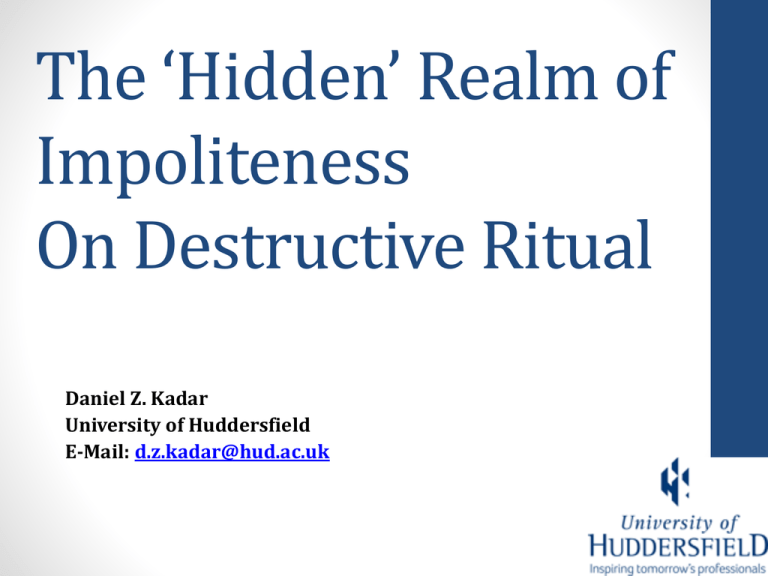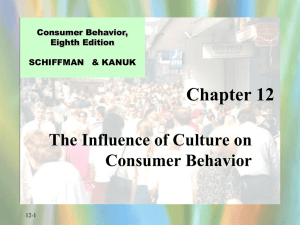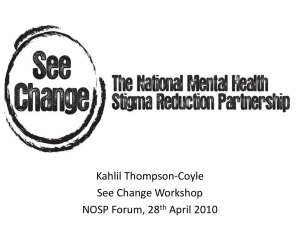
The ‘Hidden’ Realm of
Impoliteness
On Destructive Ritual
Daniel Z. Kadar
University of Huddersfield
E-Mail: d.z.kadar@hud.ac.uk
Relationally destructive ritual
practices
Broaden understanding of interpersonal politeness and
impoliteness
Post-2000 research : focus on relational acts
(predominantly contextual analysis)
Research on relational rituals: locally situated and recurrent
chains of relational acts (Collins 2004)
(potentially obscure from an analyst/outsider perspective –
examination beyond actual context)
Research on ritual
behaviour
Centre website:
www.hud.ac.uk/
cipr
Destructive ritual - definition
Destructive ritual is a formalised/schematic, conventionalised
and recurrent practice, which is relationship corrupting for the
targeted person (and potentially relationship enforcing for the
group of performers). A destructive ritual practice is
constituted by a chain of acts, and it is realised as an
embedded (mini-)performance (mimesis). This performance is
bound to relational history (and related ethos), or historicity in
general (and related social ethos).
(1) at a staff night out and after dinner we went to a bar and
the Principal said, ‘Come on, Trace, let’s find you a man.’
(Needless to say I am single)
ritualimpoliteness
interface
Why interesting?
1) Different perceptions of the analyst and/or the
observer and the participants – an alternative
understanding/methodology of impoliteness (research)
Kadar & Haugh: (2013): Im/Politeness and time
Punctuated – Emergent – Schematic & Recurrent
Recurrence tends to manifest itself in a seeming lack of
salience, or ‘hiddenness’
Awareness of recurrence
2) These practices often operate beyond the
boundaries of language.
Structure
1) Goffman’s stigma: The general interpersonal
mechanism of destructive ritual.
2) The main types of destructive ritual behaviour.
3) General discussion.
Stigma
The Greeks, who were apparently strong on visual aids,
originated the term stigma to refer to bodily signs designated
to expose something unusual and bad about the moral status
of the signifier. The signs were cut or burnt into the body and
advertised that the bearer was a slave, a criminal, or a traitor –
a blemished person, ritually [my emphasis] polluted, to be
avoided, especially in public places. (Goffman 1963: 11)
Once a markedly negative characteristic is attributed to the
victim – i.e. s/he is being stigmatised – s/he gets a “virtual
social identity” (Goffman 1963: 12).
Eglash (2002): the case of “black nerds”
Stigma (cont.) – “The normal”
Contradiction with the majority...
“We and those who do not depart negatively from the particular
expectations at issue I shall call the normal” (Goffman 1963: 15).
(2) I am an Occupational therapist in the NHS and I love my work. I
am [...] dedicated with expertise in Brain injury. [...] Over the last 5
years I have been subjected to consistent bullying where a group of
managers have talked about me in their lunch break, joked about
‘smashing my face in’, made a secret agreement not to answer my
questions in regard to a new computer system, making gestures
behind my back and many many more nasty things [my emphasis].
Feature types
1) Recurrent non-doing (ignoring)
2) Recurrent covert offence
3) Recurrent reference to the stigma
Increasing degree of directness (??)
• Culpeper (2011: 194): it cannot be taken for granted that the
more indirect an utterance is, the less offensive it becomes;
• The recurrent nature of destructive ritual practices renders
different degrees of directness and indirectness relatively
insignificant.
Recurrent non-doing
Anticipation:
Haugh (2003): anticipations involving expected behaviour are
always present in the perception of the appropriateness of a
given social act because “social norms are expectations in the
sense of thinking something is necessary”
Kadar and Haugh (2013): “Anticipating […] involves
presumptive forms of reasoning where inferences are
grounded in experience and associative links.”
It is due to the recurrence of not-performing that the stigma
value of a given ritual act is confirmed to the victim:
perception of “higher-order intentionality”
Recurrent non-doing (cont.)
(3)
Isolated – staff involved would never sit with me during
morning tea, lunches, meetings, courses, etc. My name was
omitted from birthday acknowledgements. All other staff
names on whiteboard in staff room and on work trays were in
black, only mine was in red. When we were asked to bring a
plate for morning teas or special lunches, no one ate any of
mine. I volunteered to help on many projects only to find later
that the projects had been completed without my help.
(Retrieved from:
http://www.sheilafreemanconsulting.biz/case-studies.htm)
recurrent non-doing is a practice which is often hidden from
the researcher’s and any other observer’s perspective, that is,
it is often the network insider who can properly
perceive what’s going on in such an interaction.
(4)
Everyone Plzz Stop Ignoring Me!!!!!
1. AIRFLKISAAC
(07-30-2011)
Mr.Bean ignores me pasqualina ignores me nmeade ignores me what am i not “pro ” enough for them everytime i say
hi they dont say anything and the next they say hi to some random person again am i not a “pro”mkwii racer do you
guys want me to be 9999 vr or hack the game well first of all im all legit racing second i HATE when people ignore
me..... and dont put smart alec responses on this thread it will get me even more mad and dont put this thread is in
wrong section because I DONT CARE IM TRYING TO PROVE A POINT AND ITS NOT JUSt pasqualina and mr.bean its
everyone!!!!!!!!!
2. Daphne (07-30-2011)
Actually you are. Most say that people that can keep over 9000 VR are pro.
And anyway, I’m ignoring you because playing with legit people is making me mad as of late (Except for Miller).
3. Wolfy (07-30-2011)
It’s because they don’t feel like talking to you.
Now stop bitching.
4. ξvePorta (07-30-2011)
Who cares? They don’t have to talk to the random fanboys.
Just kidding, it’s cause you’re Canadian.
5. Wolfy (07-30-2011)
Or it’s probably the Canadian thing.
6. Vices
(07-30-2011)
*Pats head*
7. 13Stark37
(07-30-2011)
you suck soul
8. tortuga (07-30-2011)
*ignored*
9. AIRFLKISAAC
(07-30-2011)
ok im sorry.... i just feel bad now
10. Flying Mint Bunny (07-30-2011)
[…]I know I would ignore him after that..
11. Γ&#Megalodon24
(07-30-2011)
xD
18. Ryan1191
(07-30-2011)
*Ignores* This is the wrong place to put this thread. Now everyone’s ignoring you
(Retrieved from: http://www.mariokartwii.com/f18/everyone-plzz-stop-ignoring-me-80655.html)
Recurrent covert offence
Kryk-Kastovsky (2006) – overt vs. covert impoliteness
Jocular abuse “often functions as a covert strategy for face-attack, a
means of registering a veiled protest” (Culpeper 2011: 215)
(5)
WHEN does a practical joke cross the line to become bullying?
This can be difficult to answer but the question should be one that
businesses consider.
[…]
Greg Robertson [...] says bullying behaviour can arise when
perceivably harmless jokes [my emphasis] get out of hand.
“What may have started as a fairly innocuous jibe, when repeated or
spread across an organisation [my emphasis] it can wreak havoc on
the targeted individual,” he says.(Retrieved from:
http://www.theaustralian.com.au/battling-bullies-at-work/storye6freqn6-1111117156319)
Recurrent covert offence
(cont.)
(1)
at a staff night out and after
dinner we went to a bar and the Principal
said, ‘Come on, Trace, let’s find you a man.’
(Needless to say I am single);
Repeated indirect attacks
Recurrent reference to
stigma
(6)
Most people imagine that the life of a prince is quite
privileged and pleasant, and although we’re sure Prince Harry
has his fair share of royal privileges, he’s also gotten more than
his fair share of taunting. The reason? His red hair. Although in
America, red hair does not carry a stigma, in the UK, “gingers”
like Harry are picked on for their coloured hair and fair skin.
Harry’s army pals frequently call him the “Ginger Bullet
Magnet,” and have joked that they would buy ginger wigs to
wear in Iraq, presumably to prevent insurgents from
identifying the young prince. (Retrieved from:
http://www.onlinecolleges.net/2011/11/02/15-famoussuccessful-people-bullied-school/)
Discussion
THANK YOU!
References
BOUSFIELD, DEREK 2010. Impoliteness in Interaction. Amsterdam and Philadelphia: John
Benjamins.
COLLINS, RANDALL 2004. Interaction Ritual Chains. Princeton, NJ: Princeton University Press.
CULPEPER, JONATHAN 2011. Impoliteness: Using Language to Causing Offence. Cambridge:
Cambridge University Press.
EGLASH, RON 2003. Race, sex, and nerds: From black geeks to Asian American hipsters. Social
Text 71(2): 49–64.
GOFFMAN, ERVING 1963. Stigma: Notes on the Management of Spoiled Identity. London:
Penguin.
HAUGH, MICHAEL 2003. Anticipated versus inferred politeness. Multilingua 22(4): 397–413.
KÁDÁR, DÁNIEL Z. 2013. Relational Rituals and Communication: Ritual Interaction in Groups.
Basingstoke: Palgrave Macmillan.
KÁDÁR, DÁNIEL Z., and MICHAEL HAUGH 2013. Understanding Politeness. Cambridge: Cambridge
University Press.
KRYK-KASTOVSKY, BARBARA Impoliteness in Early Modern English court trial discourse. Special
Issue of Journal of Historical Pragmatics 7(2): 213–245.









